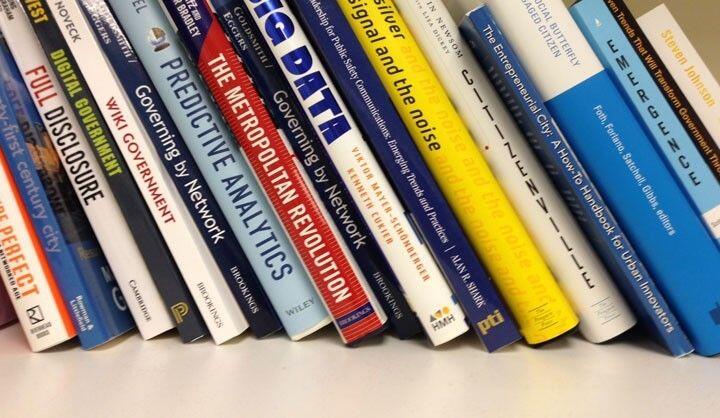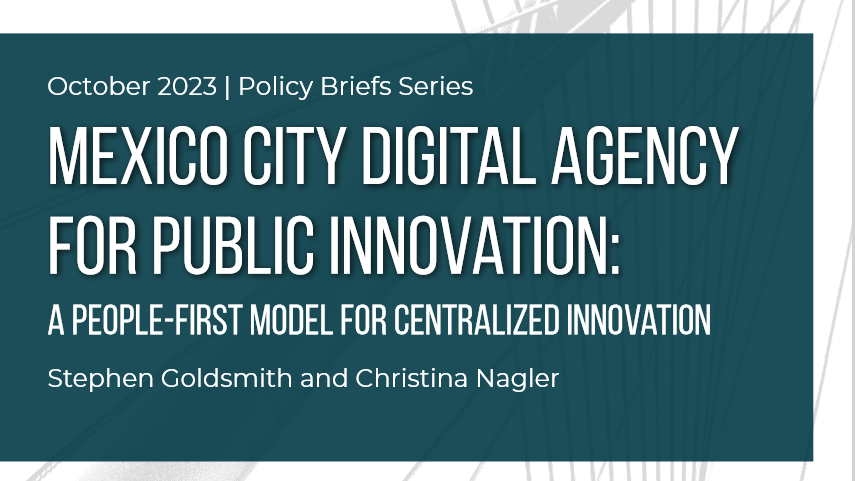- May 5, 2016
- Civic Engagement
Our #DataSmart Resources series curates links and examples for those looking for an introduction to a particular civic data topic.
Civic engagement has long been a universal concern for cities. Governments depend on constituent thoughts and feedback to guide their work, but soliciting these opinions can be difficult and time-consuming. More cities are beginning to turn to data and technology to streamline and improve their civic engagement, allowing them to connect with more residents in a more efficient manner. This post contains curated resources for cities looking to expand their civic engagement programs.
General Resources
Our civic engagement white paper series explores data-related facets of civic engagement in cities. The series includes:
- “21st-Century Civic Engagement” by Debs Schrimmer, the Content and Policy Lead for Code for America, which uses Code for America’s partnership with Boulder, CO as a case study for tech-enabled civic engagement. She provides five key recommendations for governments working to enhance civic engagement: expand reach, provide relevant and usable information, use channels effectively, encourage productive actions, and create useful feedback loops.
- “More Inclusive Governance in the Digital Age” by Hollie Russon Gilman, an Ash Center Fellow, which takes a multi-sector approach to inclusive governance and examines technology’s ability to help enable civic engagement. Her paper explores the many venues for civic engagement and provides recommendations for citizens, government, society, and digital tool developers to improve engagement.
- “Improving Service with Communication and Open Data” by Emily Shaw, the Deputy Policy Director at the Sunlight Foundation, which explains how open data can both encourage civic engagement and allow governments to get the most out of their data. The paper surveys current and historical government usages of open data, and expands on three key benefits: governments can do more with less, improve internal data practices, and improve communication with citizens.
- “Customer-Driven Government” by Jane Wiseman, leader of the Institute for Excellence in Government, which analyzes the current lack of citizen input in government and argues that the public is interesting in providing feedback and can do so successfully through surveys, social media, and 311 apps. She highlights leading models to incorporate feedback and provides a path forward for cities looking to begin leveraging citizen input.
The National League of Cities has a series of reports and research focused on civic engagement in local government. Their work covers a wide range of civic engagement topics, using successful initiatives across the country as case studies to provide advice for cities looking to engage in new initiatives. Highlights include Bright Spots in Community Engagement, Local Practices in Public Engagement, and Making Local Democracy Work.
The Engagement Lab at Emerson College published Digital Citizenship and Engagement: Guides, Playbooks, and Resources. The list contains toolkits, charts, and guides for how local governments can use the best practices in their own civic engagement initiatives, ranging from designing better voting materials to standards and measures for community engagement.
The Aspen Institute published a white paper by Peter Levine, research director of the Jonathan Tisch School of Citizenship and Public Service at Tufts University, called “Civic Engagement and Community Information: Five Strategies to Revive Civic Communication.” The paper addresses current problems with civic engagement throughout levels of government and expands upon five solutions: creating a Civic Information Corps, engaging universities as community information hubs, investing in face-to-face public deliberation, generating public “relational” knowledge, and using civic engagement for public information and knowledge. He has specific pieces of advice for cities and local governments as well, saying that they should provide physical spaces for deliberation, fund and recognize online knowledge hubs, convene deliberative forums to address public issues, promote ongoing training for deliberative democracy, and prioritize civic education in schools and include media/communication skills and media-oriented service-learning opportunities within that education.
The International City/County Management Association has a free self-assessment tool for local governments to assess their civic engagement. The tool helps governments to better understand the effectiveness of their current initiatives, key civic engagement goals, and the capacity and potential for future endeavors.
311
Beginning with early adopters like Baltimore and Chicago, 311 systems have made their way across the nation. The original premise of the 311 call center — providing a unified entry point for residents looking for a service from the city — still resonates. Today, mobile phones, social media, cloud computing, and other innovations have radically changed how we communicate, and 311 capabilities have expanded to include online and app-based services.
Boston’s BOS:311 app (formerly known as Citizens Connect) has been profiled on Data Smart before and remains a valuable use case for adopting 311 in the smartphone age. Since August 2015, Boston has used the new BOS:311 branding across a variety of platforms, including social media, the mobile app, and the traditional call center (which received almost 300,000 calls a year); smart design and savvy marketing can go a long way toward making citizens aware of these tools and encouraging them to use them. New York, Washington DC, and Houston are just some of the many cities that have followed Boston’s lead in bringing city services to the app store.
Philadelphia incorporated social media into its 311 system to create a full-service platform for civic engagement. Citizens can interact with each other through the portal’s mobile app and even organize events in their communities, according to Government Computer News. City leaders can benefit tremendously by tapping into the informal, organic social networks that define their communities — especially when they have brought that energy online.
Socrata released a white paper sketching out the relationship between 311 centers and other aspects of a modern city’s CRM toolkit. Combining the core 311 function — making and tracking service requests — “with GIS, work order management, or even licensing and permitting software” at the software level has the potential to make 311 a “one-stop shop” for citizens to connect with government, according to the report.
Many localities in the United States have both 311 and 211 systems, the latter of which are information and referral systems for human and social services developed by the nonprofit United Way. The International City/County Management Association has published a helpful white paper on 211 and 311 consolidation, taking New York City as a case study and assessing the possibilities for both outright consolidation and looser collaboration.
Crowdsourcing
The term “crowdsourcing” refers to the process of obtaining needed services, ideas, or content by soliciting contributions from large groups of people. Federal, state, and city governments everywhere are embarking on crowdsourcing initiatives in various and creative ways.
Some cities have adopted crowdsourcing programs that enable citizens to more easily share data and comments with governments. In Detroit, a blight task force of more than 100 people identified vacant properties across the city by sending photographs, lot characteristics, and structure conditions to the operations center using a mobile app called LocalData that was initially created for the project. This data allowed the city to map the blighted properties, locate candidates for demolition, and pinpoint areas of elevated safety concern. LocalData has since been used by a number of cities on a variety of projects, and is a useful tool that can be utilized (for a price) by any city looking for a premade and effective method of gathering citizen-sourced data.
Governments have also been able to utilize the expertise of constituents to solve tricky problems. Challenge.gov, a website created by the federal government, allows agencies to award cash prizes to citizens who provide solutions to their posted challenges. IBM’s report Using Competitions and Awards to Spur Innovation explores challenge programs more broadly. This report explains how governments can use challenge programs as a way of “connecting people who have innovative ideas to people in government who can implement these ideas.”
Other crowdsourcing initiatives have been designed to help governments assess their performance. In Washington, Grade D.C. combines feedback solicited from its website with relevant mined social media comments to assign grades to city agencies. These grades help ensure agencies are accountable for their performance and indicate where service is most in need of improvement.
IBM’s Center for the Business of Government has been a research leader on crowdsourcing in government. Most of the center’s reports focus on federal programs, but many of the insights hold true at the state and city level. In addition to the aforementioned Challenges Report, they have a number of others that analyze this topic:
- Using Crowdsourcing in Government provides an overview of the government crowdsourcing process, identifying forms of crowdsourcing, outlining strategies, and highlighting best practices. Included in the report is a list of ten suggestions for governments undertaking crowdsourcing initiatives.
- Federal Ideation Programs focuses on ideation, a more specific niche of crowdsourcing. The report distinguishes this subset, stating: “Crowdsourcing can refer to any task divided up and distributed to a large group, while ideation refers specifically to posing questions or concerns for collecting, synthesizing, analyzing, or prioritizing ideas and pointing to next steps.” This report outlines the challenges and best practices of harnessing citizen brainpower through the medium of ideation platforms.
- Beyond Citizen Engagement focuses on how to tap into citizen manpower. The report outlines strategies to help government engage willing citizens in co-designing, co-producing, and co-delivering government programs and services.
Social Media
As social media usage has skyrocketed in the past decade, so has its potential as a civic engagement tool for cities.
We published an overview of city governments' social media usage, exploring how social media allows cities to more easily share information, hold two-way conversations, engage millennials, receive feedback, and make informed decisions. Similarly, Civic Plus explored seven types of content that cities have successfully shared on social media to engage citizens, ranging from crime reports to road closures.
For cities looking for information about specific social media platforms, a number of resources exist:
- Facebook: GovTech published a short video covering the basics of Facebook for governments. Fast Company explains additional Facebook apps and plug-ins that local governments can use to allow citizens to easily report issues and submit service requests.
- Twitter: IBM Center for the Business and Government published a report on government usage of Twitter; the in-depth report covers Twitter basics as well as insights and strategies gleaned from current government Twitter accounts. Development Counsellors International identified 25 “Tweet Elite” mayors who are most effectively using Twitter to engage with their constituents. The accompanying report includes best Twitter practices and advice from the recognized mayors.
- Snapchat: Snapchat, an instant photo-sharing app, is one of the newer forms of social media that cities are beginning to experiment with. GovLoop covered the basics of Snapchat for government, highlighted successful government Snapchat accounts, and explained the records keeping requirement (an important part to remember, since Snapchat pictures are meant to disappear).
The possibilities for cities to enhance civic engagement initiatives are endless. Cities can now more easily share information, connect with citizens, crowdsource solutions, and gain feedback to improve their own services. New technology and data-driven initiatives continue to launch, making new ways of civic engagement possible. To stay updated on the latest civic engagement news, be sure to follow our Civic Engagement posts here on Data-Smart.




